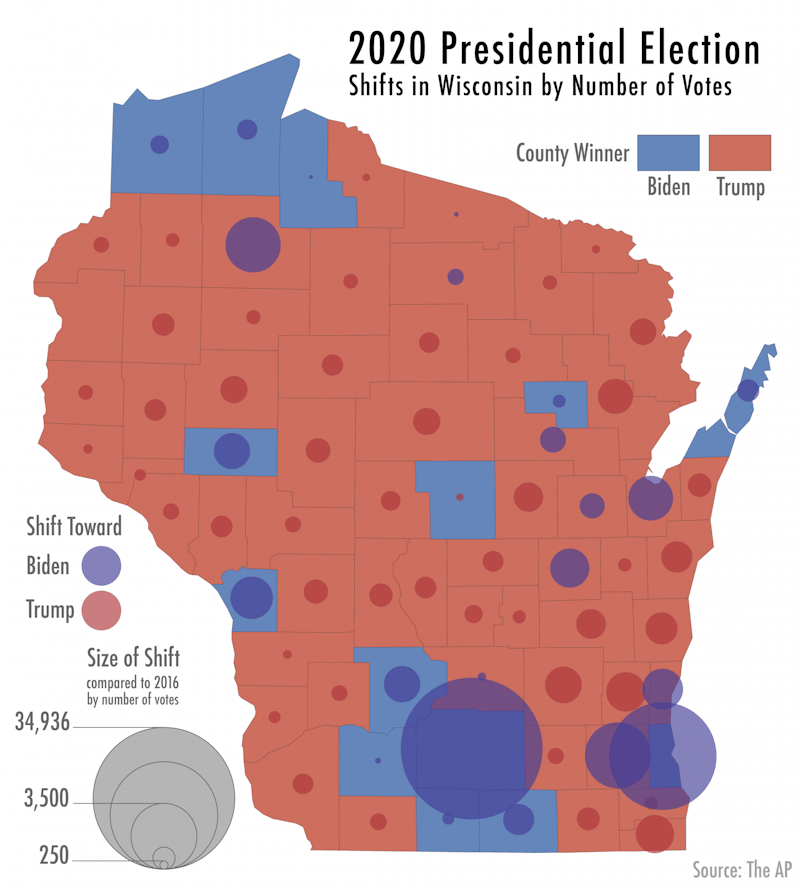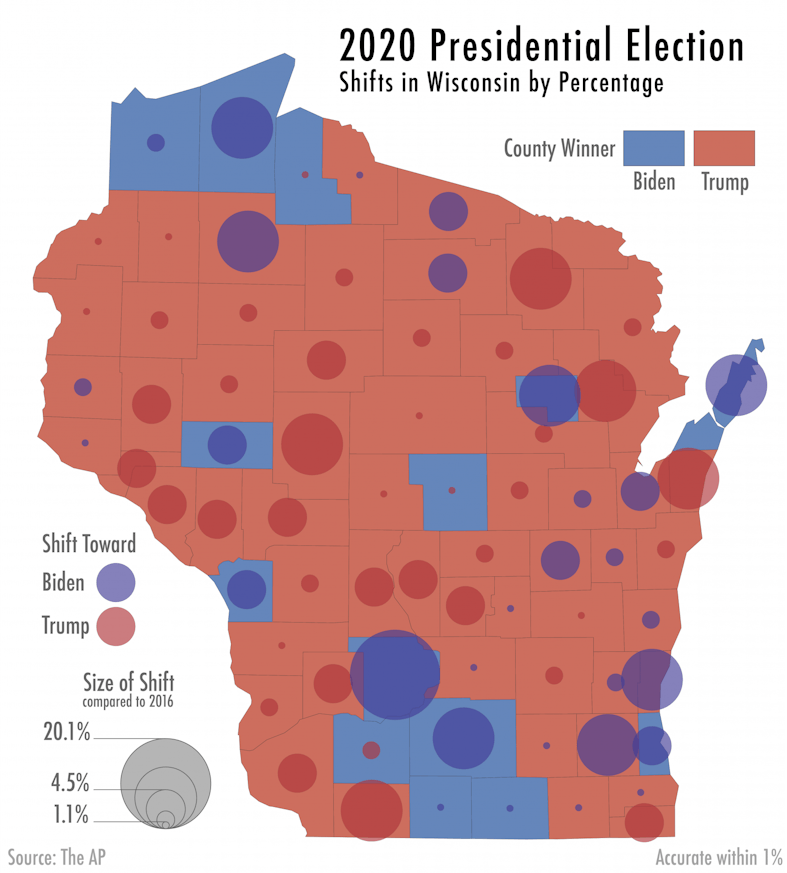
With final margins looking strikingly similar to 2016, Biden was able to pull enough votes out of Dane and Milwaukee County to secure the state.
Image By: Lily Houtman
With final margins looking strikingly similar to 2016, Biden was able to pull enough votes out of Dane and Milwaukee County to secure the state.
Image By: Lily HoutmanWisconsin flipped blue in this election as former Vice President Joe Biden won the state by a razor-thin 20,000 vote margin, matching President Trump's margin of victory in 2016.
Wisconsin saw a record turnout, like much of America, with over 260,000 more votes cast than any previous presidential election — though it didn’t quite break the record for turnout percentage set in 2004. Unofficial totals show turnout up in all 72 Wisconsin counties by an average of about five percent.
However, all but two counties voted for the same presidential candidate’s party in 2020 that it did in 2016, and often by larger margins, which suggests increased political polarization in the state.
So where did Biden make up the difference in Wisconsin, and how did increased voter turnout affect the final count?
Increased voter turnout per-county by percentage
Wisconsin saw its highest voter turnout as a percentage of voting age population since 2004 in this election, with the highest turnout increases in the northwest, east and center of the state.
Sauk County saw a huge increase in turnout compared to 2016, while Sheboygan and St. Croix counties also saw larger than 15 percent increases.

Milwaukee County, which was ultimately vital to Biden’s victory in Wisconsin, saw the smallest increase in turnout with just under a 1.5 percent jump.
Exit polls suggest that Biden overwhelmingly won young voters — though data also shows turnout in Milwaukee and Madison college neighborhoods was significantly down this year.
Additionally, both Sauk and Door counties — the two counties that flipped in this election — saw large increases in voter turnout, and both turned Democratic.
Shift by vote margin
At first glance, this map shows an overwhelming amount of red. Trump saw an increase in vote margin in 42 of Wisconsin’s 72 counties.
Vote margin is the percentage differential between each candidate's vote total, and does not account for population.
Most of Trump’s gains were fairly modest. He averaged a 2.38 percent increase in counties where his margin grew from 2016.

Biden increased the Democratic vote margin in the other 30 counties, improving on Clinton’s 2016 margins more than Trump did on his — though they were also mostly modest gains.
Biden averaged a 2.8 percent increase over counties he increased the margin in from 2016. Though, Biden did increase his margin by more than five points in seven counties, compared to just two counties with that gain for Trump.
Biden’s margin increased most in Sauk County, which flipped blue for the former Vice President. Door County, the other county to flip in this election, saw an eight point swing from 2016.
Sauk is considered a bellwether state for Wisconsin, and its vote this year again matched the state’s outcome. Door County, which voted for Trump in 2016, has had its tourism industry hit hard by the COVID-19 pandemic.
Shift by number of votes
The shift in vote margin on its own is slightly misleading, as third party candidates in 2016 shaved votes away from Hillary Clinton, which inflates Biden’s 2020 margins.
Trump gained votes in 49 counties in Wisconsin, compared to just 23 for Biden. Trump only gained an average of 733 votes over those 49 counties while Biden gained over 1,100 votes per county in the 23 he won.

With final margins looking strikingly similar to 2016, Biden was able to pull enough votes out of Dane and Milwaukee County to secure the state.
Additionally, over 25 percent of Wisconsin’s population lives in just two counties, Dane and Milwaukee, which voted overwhelmingly Democratic in this election. Dane County added nearly 35,000 votes for Biden, while Milwaukee county added another 20,000.
Waukesha County, while ultimately voting for Trump, added the third most votes for Biden with over 7,000 votes gained for the candidate.
Gains in those three counties alone would have sealed the victory for Biden, though Democratic votes in Brown and Sawyer counties also contributed to his final margin.
What this means
The national political spotlight was on Wisconsin in the weeks and months leading up to the election — not only because of its perennial status as a swing state, but also because of protests and riots that followed the shooting of Jacob Blake in October and frequent campaign stops by both parties.
Unofficial results seem to suggest that both sides did a good job getting out their vote. Nearly every county in Wisconsin became more polarized when compared to 2016. In most cases, Democratic counties continued to get more Democratic, while Republican areas got more Republican.
The close race also suggests that pollsters missed the mark for the second consecutive presidential election, after nailing 2018 midterm results. Multiple polls for Wisconsin showed Biden anywhere from 9-17 points ahead of Trump, including one released days before the election by the Election Research Center at UW-Madison. Biden ultimately won by about 0.6 percentage points.
Trump has called for a recount in the state, however it is doubtful that a recount would change the outcome in the state.
All data for this article is from official Wisconsin 2016 recount numbers, and unofficial data on the 2020 election provided by the New York Times and The Associated Press.